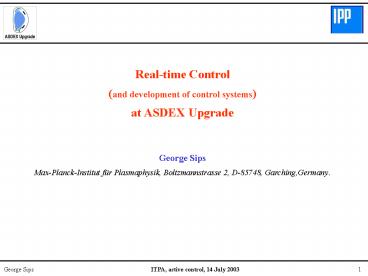George Sips ITPA, active control, 14 July 2003 - PowerPoint PPT Presentation
Title:
George Sips ITPA, active control, 14 July 2003
Description:
Control of q-profile, with on-line q(r) identification. ... Neutral beam power modulated for optimum response on current diffusion time scale ... – PowerPoint PPT presentation
Number of Views:41
Avg rating:3.0/5.0
Title: George Sips ITPA, active control, 14 July 2003
1
Real-time Control(and development of control
systems)at ASDEX Upgrade George
Sips Max-Planck-Institut für Plasmaphysik,
Boltzmannstrasse 2, D-85748, Garching,Germany.
2
Areas for plasma control (development) at ASDEX
Upgrade
- Control of plasma performance (density profile,
regime identification). - Control of MHD instabilities (NTMs, sawteeth,
ELMs, ELM type). - Control of q-profile, with on-line q(r)
identification. - Other control schemes including plasma protection.
Covers many physics areas, and various different
diagnostic input data in real time.
3
Actuators at ASDEX Upgrade
4
Control of density profile
Off axis heating Peaking of density profile, but
MHD unstable (NTMs). Use of central ICRH or
ECRH Can control the density peaking.
AIM Density profile control, also including the
heating power as actuator
5
Control of High Z impurities in the core
Improved H-mode NBI 5 MW (2.5 MW off axis),
ECRH, no sawteeth. With ECRH Density peaking
reduced, no accumulation of Tungsten.
6
Regime identification
H-mode or L-mode
If you would like to know if the discharge is in
L-mode or H-mode. Important for other control
schemes Density feedback, plasma protection,
divertor. Use of power threshold scaling law is
not sufficient at all.
7
Regime identification
Construct training data set gt 3000 observations
(by hand). Identify H-mode or L-mode. Improved
H-mode or not. Store for each data point 0-D
diagnostic data. Automated search using
discriminant analysis on best variables to use
and optimimum number of variables.
H-mode or L-mode dataset.
8
Regime identification
H-mode or L-mode. Variables used for
identification Ploss,q95,bp,Ip,Vloop
Similar good results for Improved H-mode or Not
Probability x100
9
3/2 NTM stabilisation
- More ECRH power, new mirror system for launch
angle control. - NTM detection algorithm using real time Te(r) data
10
Sawteeth control with ECCD
Co-ECCD
- Sawteeth stabilisation (A. Mück)
- Counter ECCD, inside q1 surface.
- Co ECCD, just outside q1 surface.
- ECCD deposition tuned with B-field.
New gyrotrons and mirror systemfor 2003/2004
11
Control of ELM behaviour plasma shape
q95 3.6, dsep. 0.43, bN3.5
q95 3.7, dsep. 0.44, bN3.2
q95 4.4, dsep. 0.34, bN2.2
q95 3.3, dsep. 0.17, bN3.0
12
Control of ELM type Type II ELMs access
conditions
- q95 gt 3.5, pure Type II ELMs possible.
- 0.85 lt ne/nGW lt 0.95.
- Close to double null shape.
Type II
13
Controlled external ELM triggering
Small pellets at 20 Hz are used to trigger ELMs
(P. Lang)
14
Motivation for current profile control at ASDEX
Upgrade
- NBI system at ASDEX Upgrade
- 2 NBI sources (6, 7) at NI-2 are off-axis,
- tangential injection at 93kV, Deuterium
- Higher current drive efficiency
- With other NB sources Control of
power/particle deposition
15
Current profile control at ASDEX Upgrade
16
ASTRA Simulations of 4 different NBI sources
17
Astra Simulation vs Experiment at 400 kA
17530
Different NBI sources
MSE signal exp .VS. ASTRA
18
ASTRA Simulations of modulated NBI sources
ASDEX Upgrade
ASDEX Upgrade
- Neutral beam power modulated for optimum
response on current diffusion time scale
2 4 6 8
10
These simulations are used to identify the system
response function
19
System identification and validation with step
response
best result
Source8 - j(0.225)
worst result
20
Otrher control schemes
- Control of several neutral particle flux
densities via D gas injection. - Choice of several different line densities
control via D gas injection. (including edge
density and possibility to switch during the
pulse). - Control of these line densites with pellet
injection. - Control of Tdiv (thermoelectric currents), or
control of Pdiv via impurity gas injection. - Control of isotope mix H/(HD).
- Reduction of Halo currents.
- Pulse repair from Deep Detachment.
21
Control of H/(HD) mixure and line average density
22
Reduction of Halo current during disruptions
O Without Killer pellet. ? With mode-lock
detector. X With Killer pellet.
Killer pellet activated with Neural net, trained
to predict time to disruption. But network ages
rapidly, to give lt 80 reliability.
23
Deep detachment repair vs. Termination with
killer pellet
Repair, But experiment compromised ?
Termination, Experiment finished Machine safe.
24
Design of new digital control system (ready 2003)
Present system (own design) Transputer network,
t 2 - 5 ms New system (commercial) Shared
memory netw. t 1 ms
Termination, Experiment finished Machine safe.
25
Conclusions
Major new real time control schemes are being
developed for ASDEX Upgrade Density profile
control, Regime identification, NTM and sawtooth
stabilisation, ELM control and current profile
control. Together with existing control scheme
and real time diagnostic measurements form a
consistent set of control tools. New real time
control hardware is being installed and should be
ready for commissioning in 2003































